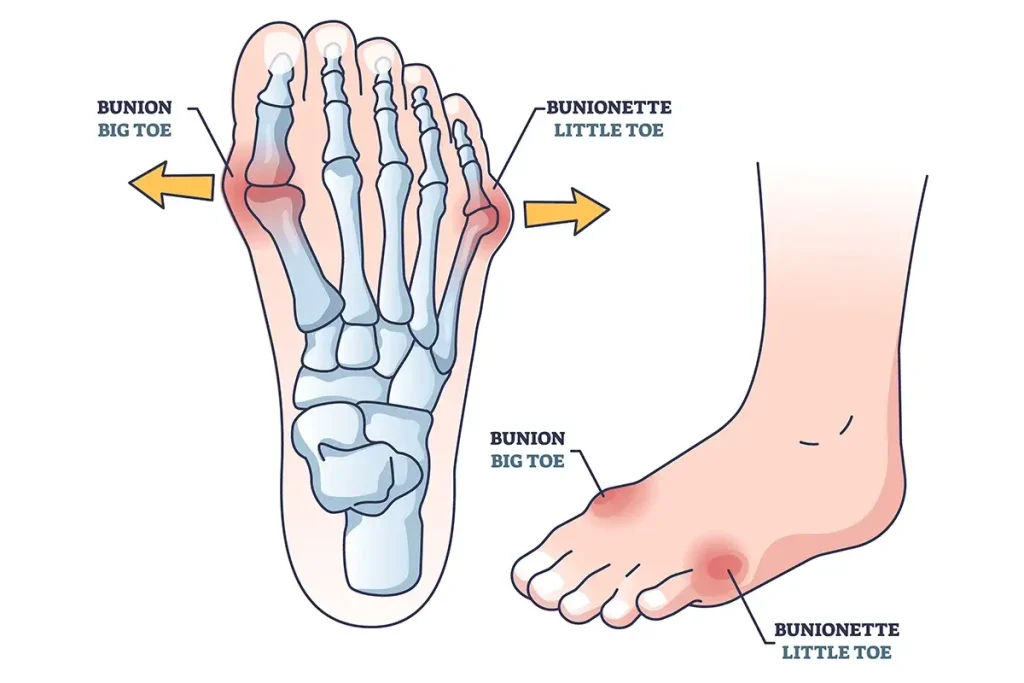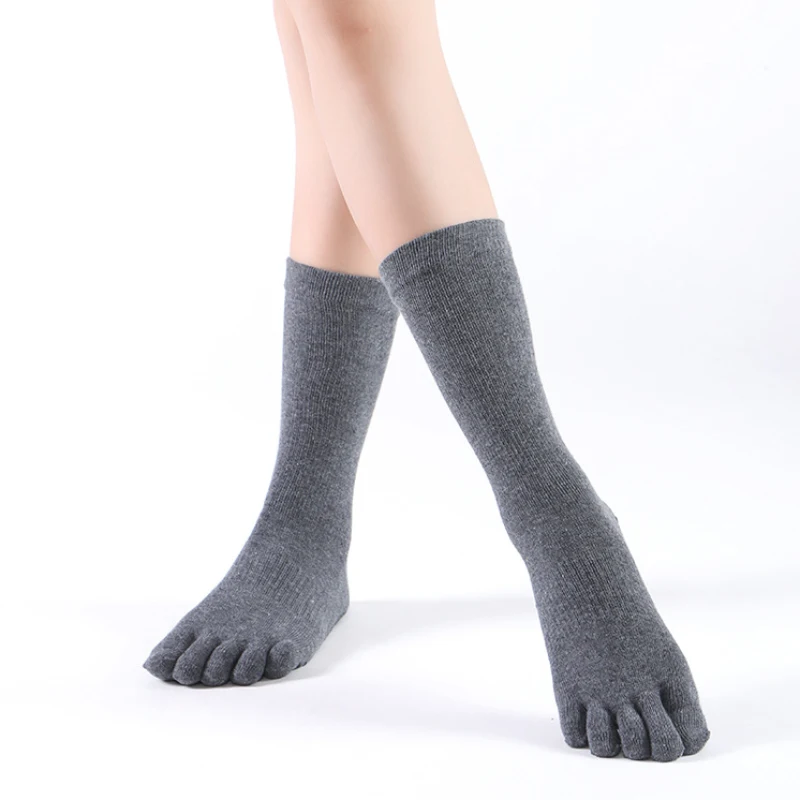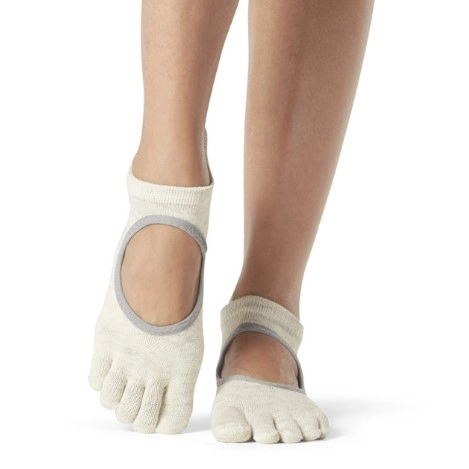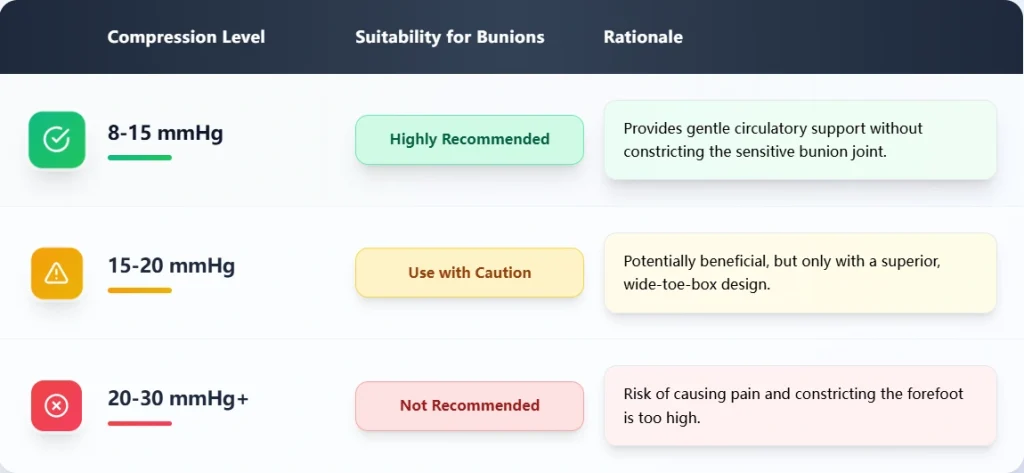Introduction: The Uncomfortable Reality of Bunions and the Search for Relief
Bunions affect millions, causing daily pain, swelling, and frustration—especially during movement. As a wellness or apparel brand, addressing this discomfort can unlock real value for your customers. With compression socks trending for foot health and recovery, the question arises: can compression socks actually help people with bunions—or make it worse?

While compression socks cannot cure or correct the underlying bone structure of a bunion, they can provide significant relief from the symptoms. The gentle pressure helps reduce painful swelling and inflammation around the joint by improving blood circulation. This can ease daily discomfort and make standing or walking more tolerable.
The answer depends on design. Standard compression socks with tight toe boxes may aggravate the issue. But socks with strategic compression, roomier toe areas, and seamless construction can offer genuine relief. For product developers, understanding these features is key to creating a product that supports foot health without sacrificing comfort.
In this guide, we’ll break down the relationship between bunions and compression, what to avoid in sock design, and how to build a bunion-friendly compression sock that aligns with both wellness needs and customer expectations.
What Exactly is a Bunion? Understanding the Root Cause of the Pain
Before we can even discuss potential solutions, we must have a crystal-clear understanding of the problem. A common misconception is that a bunion is simply a bump of bone that grows on the side of the foot. In reality, it’s a much more complex structural deformity of the foot, known medically as Hallux Valgus. This condition occurs when the long bone in the foot (the first metatarsal) starts to drift outward, away from the smaller toes, and the big toe (the hallux) begins to point inward, toward the second toe. That prominent “bump” is actually the head of the metatarsal bone, which has become misaligned. Understanding this is crucial because it clarifies that a bunion is a skeletal issue, not just a surface-level problem.
So, where does the pain come from? The discomfort associated with bunions arises from several factors, and a well-designed sock can only address some of them.
- Joint Pressure and Inflammation: The misaligned joint (the metatarsophalangeal, or MTP, joint) is often inflamed, arthritic, and painful. This internal pain is a primary source of discomfort, especially when walking.
- Friction from Footwear: This is a major external factor. The prominent bump constantly rubs against the inside of shoes, leading to redness, calluses, blisters, and intense tenderness on the skin and the underlying bursa (a fluid-filled sac that can also become inflamed, a condition known as bursitis).
- Nerve Compression: In some cases, the pressure from the bunion and tight footwear can compress small nerves in the foot, leading to tingling or numbness in the toes.
- Secondary Foot Pain: The change in foot mechanics caused by a bunion can lead to other issues, such as hammertoes, corns, and general aching or fatigue across the entire foot as it tries to compensate for the imbalance.
Here’s the bottom line. A sock cannot reverse the skeletal misalignment of a bunion. Any product claiming to “correct” or “cure” a bunion is making a false medical claim. However, a sock can be engineered to reduce friction, provide protective cushioning, and alleviate the secondary swelling and aching that contribute so much to a person’s daily discomfort.
The Primary Role of Compression Socks: A Circulatory Supercharger
Before evaluating their impact on bunions, it’s essential to understand that compression socks function primarily as medical-grade circulatory aids. Their core purpose is to improve blood flow in the lower legs using a principle called graduated compression—a technology found in every effective compression garment.
When you stand or sit for extended periods, gravity causes blood and fluids to pool in your ankles and feet. This leads to swelling, heaviness, and fatigue. By contrast, compression socks apply a controlled level of tightness at the ankle that gradually decreases toward the knee, creating an engineered pressure gradient. This gradient gently “squeezes” your veins, helping overcome gravity and promoting more efficient venous return to the heart.
How Graduated Compression Works
- Engineered Pressure Gradient: The sock’s tightest point is at the ankle, reducing steadily up the calf.
- Enhanced Venous Return: This design assists your veins in pushing deoxygenated blood back to the heart.
- Reduced Swelling & Fatigue: Improved circulation prevents fluid buildup (edema) and alleviates tired, achy legs.
Why This Matters for Bunions
While compression socks do not directly reshape bone or realign joints, the improved circulatory environment they create can ease secondary symptoms of bunion pain—namely swelling, inflammation, and local discomfort. By reducing fluid retention around a bunion, these socks may help soften pressure on irritated tissue, making movement more comfortable.
In the next section, we’ll explore the specific sock features—such as roomier toe boxes, seamless construction, and targeted padding—that leverage this circulatory boost to provide targeted relief for bunion sufferers.
The Direct Answer: Can Compression Socks Help Bunions?
When it comes to compression socks for bunions, the answer isn’t a simple yes or no—it’s a qualified “yes.” Generic, high-compression socks can aggravate bunions by squeezing the forefoot and increasing joint pressure. However, a thoughtfully engineered bunion-friendly sock can offer meaningful relief through gentle support, strategic padding, and improved circulation.
Why Standard Socks Fail
Regular compression garments focus on firm pressure. This works for swelling or muscle recovery but can worsen a bunion (Hallux Valgus) by compressing the already sensitive forefoot. Using these socks without design adjustments often leads to more pain and friction.
What Bunion-Friendly Socks Do
Instead of tight forefoot compression, these specialized socks deliver mild, graduated support that reduces overall foot swelling. Less fluid retention means reduced shoe pressure and, indirectly, less stress on the bunion. They also feature targeted cushioning over the bunion area to protect against friction and impact.
Enhancing Daily Comfort
Beyond protecting the bunion itself, improved arch support and gentle compression enhance blood flow, reducing foot fatigue and overall discomfort. While no sock can realign your bones—you’ll still need orthotics or medical treatment for that—a bunion-friendly sock can make every step significantly more comfortable.
Key Takeaway for Brands
Don’t market standard compression socks as a bunion cure. Instead, design a sock that balances mild graduated compression, cushioned protection, and foot-support elements. This combination addresses the unique needs of bunion sufferers and positions your product as a trusted solution in a competitive wellness market.
Indirect Benefits: How Improved Circulation Eases Bunion Discomfort
Compression socks can’t realign the big toe joint, but by enhancing blood flow, they trigger a series of indirect benefits that make living with bunions more comfortable. Bunions create a ripple effect of pain—from sharp joint aches to friction-induced irritation and overall foot fatigue. A well-fitted, graduated compression sock helps calm this entire system by optimizing the circulatory environment.
Mitigating Foot Swelling
People with bunions often notice their entire foot swells after prolonged standing or walking, squeezing shoes tighter and amplifying bunion pressure. A sock with gentle, graduated compression combats fluid buildup by promoting lymphatic drainage and venous return. The result? Reduced overall foot volume and a less constricted environment around the bunion, translating to noticeable pain relief when your customers move.
Reducing Aching and Fatigue
Circulation is key to flushing out metabolic waste and delivering oxygen-rich blood to tired muscles. Compression socks stimulate this process, easing that “heavy, achy” sensation common in bunion sufferers. As general foot discomfort decreases, the relative intensity of bunion pain often dims, improving overall comfort and mobility.
Supporting Skin Health
Constant rubbing and pressure on a bunion can compromise skin integrity, leading to redness, calluses, or even ulcers. Improved circulation nourishes the skin with essential nutrients and oxygen, strengthening the skin barrier and making it more resilient against daily friction. Healthier skin means fewer secondary issues and happier customers.
By focusing your product messaging on these circulation-driven advantages, you can position compression socks not as a cure, but as a powerful, evidence-based solution that transforms bunion discomfort into manageable daily wear.
The Real Game-Changer: Sock Design Matters More Than Compression
When targeting customers with bunions, compression alone won’t solve their pain. In fact, applying high pressure with the wrong sock design—like narrow toe seams or tight top bands—can actually make symptoms worse. For brands developing wellness products, prioritizing bunion-friendly design is not optional; it’s essential.
Prioritize a Roomy Toe Box
The front section of the sock should allow toes to spread naturally. A snug, tapered toe pushes the big toe inward, worsening the bunion angle and increasing pain. Design the sock to match the foot’s natural contours, even if that means extra space at the forefoot.
Eliminate Friction with Seamless Toes
A true seamless toe—ideally hand-linked—prevents rubbing across sensitive areas. For bunion sufferers, even a small seam can lead to irritation. Flat finishes reduce skin breakdown and support day-long comfort.
Add Padding Where It Matters
Strategic cushioning over the bunion zone creates a protective barrier between the foot and the shoe. This targeted relief softens pressure points without increasing bulk elsewhere in the sock.
Ensure Gentle Support and Fit
A non-binding top band prevents circulation issues, especially for socks offering mild compression. Likewise, including gentle arch support helps people with flat feet—common among bunion sufferers—maintain foot alignment and reduce fatigue.
For this segment, sock design isn’t cosmetic. It’s the core value proposition. Compression is useful, but only when the sock’s shape, seam construction, and support zones are tailored for sensitive, misshaped feet. Prioritize structure over squeeze to truly serve this audience.
Choosing the Right Materials: Softness, Stretch, and Seamless Comfort
Selecting the ideal fabric blend is crucial when designing bunion-friendly socks. The skin over a bunion is often sensitive, inflamed, and prone to irritation. That makes material softness and seamless construction essential to prevent further discomfort. Equally important is moisture control: damp environments encourage friction and skin breakdown, exacerbating bunion pain.



Soft, Skin-Friendly Fibers
A premium sock blend should begin with ultra-soft fibers:
- Bamboo stands out for its natural silkiness, breathability, and antimicrobial qualities, helping keep feet fresh.
- Merino wool offers finest-gauge comfort and excellent temperature regulation, wicking sweat while staying luxuriously soft.
- Combed cotton or mercerized cotton provides durability and gentleness, eliminating coarse fibers that irritate sensitive skin.
Elasticity and Fit
To accommodate the wider bunion area without tightness, the fabric must stretch evenly:
- High-quality Spandex (Lycra) delivers adaptive stretch and recovery, ensuring the sock maintains its shape and gentle support throughout wear.
- Blends with higher Spandex percentages allow a snug, yet forgiving fit that moves with the foot.
Advanced Moisture Management
Effective moisture-wicking prevents blister formation and skin maceration:
- Coolmax or hydrophobic polyester fibers pull moisture away from the skin, keeping the foot dry.
- Nylon adds durability without sacrificing breathability, creating a lasting sock that feels lightweight against the skin.
A thoughtfully engineered mix—such as bamboo or Merino for comfort, durable nylon, and ample Spandex—creates a sock that cradles bunions without pressure. For wellness brands, emphasizing these premium materials and their benefits—softness, stretch, and moisture control—reinforces your product’s value in alleviating bunion discomfort.
Compression Levels: Finding the Right Pressure for Bunion-Friendly Socks
For customers with bunions, selecting the correct compression level is essential. The goal is to improve circulation and reduce swelling—without adding stress to the already sensitive first metatarsophalangeal (MTP) joint. Compression that is too strong in the forefoot can quickly lead to discomfort or pain. That’s why understanding mmHg ratings is vital when developing compression socks for this segment.
8–15 mmHg (Mild Compression)
This range is the most suitable for individuals with bunions. It provides gentle support that enhances blood flow and reduces mild swelling, especially around the toes and arch. Because this level does not apply strong pressure, it helps users stay comfortable throughout the day without irritating the bunion. For brands targeting this market, this should be the default starting point.
15–20 mmHg (Moderate Compression)
This level may work for some, particularly those experiencing significant leg fatigue or edema. However, it requires a careful sock design. The toe box must be wide and flexible to prevent compression on the bunion. This level can be beneficial for active wear or travel but should be positioned carefully in marketing materials due to its narrower suitability.
Above 20 mmHg
Compression levels exceeding 20 mmHg are rarely appropriate for bunion sufferers. These are typically reserved for medical-grade needs like post-operative recovery or venous disorders. Applying this level of pressure to the forefoot may increase pain and worsen joint irritation, making it a poor choice for general bunion relief products.

Compression Socks Within a Broader Bunion Relief Strategy
Compression socks can play a valuable role in managing bunion discomfort, but they should never be positioned as a standalone fix. For brands aiming to offer responsible solutions, it’s important to present compression socks as part of a larger bunion care strategy. This approach shows your customers that you understand the complexity of bunions and that you care about their long-term foot health—not just short-term symptom relief.
Supporting Sock Use with Complementary Methods
Customers often experience the best results when compression socks are used alongside other non-invasive methods. Footwear plays a foundational role. Advise your customers to pair their socks with shoes that feature a wide toe box, low heel elevation, and strong arch support. A bunion-friendly sock performs best when worn in shoes that don’t compress or misalign the forefoot.
Orthotic inserts can also make a meaningful difference. By correcting mechanical imbalances, they relieve pressure across the metatarsal area and improve gait. Your compression socks should be soft and stretchable enough to accommodate orthotics without restricting circulation.
Foot exercises like toe stretches or towel scrunches can maintain joint mobility and prevent stiffness, which is especially important for those with developing bunions. For added support, users may choose toe spacers or bunion pads during rest periods.
Encourage customers to consult a podiatrist if their symptoms persist. Combining medical advice with smart product use positions your compression sock offering as a reliable component of comprehensive bunion care.
By taking this well-rounded approach, your brand becomes more than a product provider—it becomes a partner in improving foot health.
Design Mistakes That Can Worsen Bunion Pain
When developing socks for customers with bunions, understanding what not to include is just as critical as knowing what works. Poor design choices can turn a helpful product into one that worsens foot pain—damaging both your customer’s trust and your brand’s reputation.
The Shape Matters: Avoid Tapered Toe Boxes
One of the most common problems in standard sock designs is the symmetrical or narrow toe box. Human feet are not perfectly tapered, especially when bunions are present. Socks that squeeze the toes together will apply direct pressure on the bunion joint, increasing irritation and pushing the deformity further out of line. Prioritize an anatomically shaped toe area with more width.
Seam Placement and Material Quality
Rough seams across the toe area can create friction points. This is especially problematic for those with sensitive skin or structural foot issues. Opting for seamless or flat-knit toe designs reduces rubbing and helps prevent skin damage. Material selection is also key: low-stretch, stiff fabrics will not accommodate swollen or misaligned joints. Look for soft, high-elasticity yarns that contour without squeezing.
Misplaced Compression Zones
Compression should support circulation around the calf and arch, not restrict the forefoot. Applying pressure over the bunion area is not only ineffective—it may make the pain worse. A non-restrictive forefoot combined with gentle midfoot support offers a more practical solution.
Traction and Stability Considerations
Customers with bunions often struggle with balance. Smooth, synthetic soles can contribute to slips, particularly on tile or wood. Adding subtle grip patterns or texture to the bottom of the sock enhances safety, especially for home or studio use.
By avoiding these design flaws, brands can develop socks that truly meet the comfort and safety needs of people with bunions.
Marketing Your Bunion-Friendly Socks Responsibly
Positioning a bunion-friendly sock requires honest, clear messaging that builds trust with a skeptical audience. Many bunion sufferers have encountered products making grandiose, unverified claims. Your brand’s credibility hinges on steering clear of medical promises while highlighting the tangible comfort features that truly matter.
Lead with Design, Not Cures
Avoid any suggestion that your socks will “fix” or “cure” bunions. Instead, emphasize how your design eases daily discomfort. Describe the wide toe box that prevents pinching, the seamless construction that eliminates rubbing, and the strategically placed cushioning that shields sensitive joints. When you frame gentle compression as a secondary benefit—helping to reduce mild swelling and fatigue—it reinforces comfort without overpromising.
Educate and Empower
Use your website, blog, and social media channels to become a reliable resource on bunion care. Offer articles or videos about bunion causes, proper shoe selection, and foot health tips. Show how your socks integrate into an overall wellness routine. This educational approach positions your brand as an authority rather than just another product pitch.
Showcase Genuine Experiences
Gather testimonials from real customers who report all-day comfort, reduced friction, and improved mobility. Share before-and-after stories, but keep them authentic and specific. Authentic user feedback not only enhances SEO—through keyword-rich reviews—but also resonates with prospective customers searching for “bunion relief socks” online.
By combining transparent product positioning, helpful education, and sincere customer testimonials, you’ll differentiate your bunion-friendly sock line in a crowded market. This responsible marketing strategy fosters lasting loyalty and drives organic search visibility for wellness shoppers seeking real, trusted solutions.
Conclusion: Partner with Experts to Create Truly Comfortable Bunion Socks
Compression socks can help bunion sufferers—but only when designed specifically for their needs. A sock with a wide, seamless toe box, targeted cushioning, and gentle graduated compression offers real relief. Brands should focus on comfort first, using compression as a supportive feature rather than the main selling point.

Developing such specialized socks demands expert manufacturing knowledge. Partnering with a trusted factory ensures quality and innovation.
Ready to offer your customers genuine bunion relief and build lasting brand loyalty? Contact Max Hosiery today for a free consultation and start creating a product that truly makes a difference.
FAQ Section
Q1: Can we legally market our product as a “bunion correction sock”?
No. This would be considered a medical claim that implies the sock can fix the underlying skeletal deformity. Such claims are highly regulated and, in this case, scientifically inaccurate. It’s much safer and more honest to market it as a “bunion relief sock” or “bunion-friendly comfort sock.”
Q2: What is the single most important design feature for a sock targeting bunion pain?
The most critical feature is a wide, anatomical toe box combined with a seamless toe closure. This combination prevents the painful squeezing and rubbing that is the primary complaint for bunion sufferers when wearing standard hosiery.
Q3: What is the ideal compression level to start with for a bunion-friendly product line?
The ideal starting point is a mild compression level of 8-15 mmHg. This provides the circulatory benefits of reducing swelling and fatigue without putting excessive or painful pressure on the sensitive bunion joint.
Q4: Is a bunion-friendly compression sock a substitute for seeing a doctor?
Absolutely not. These socks are a tool for managing symptoms and improving comfort. Brands should always encourage their customers to consult with a podiatrist or healthcare professional for an accurate diagnosis and a comprehensive treatment plan.
Q5: What materials are best for a sock designed for bunion relief?
The best materials are a blend of soft, non-irritating fibers like Bamboo or Merino wool, combined with a high-quality elastic like Lycra for adaptive stretch, and a durable, moisture-wicking synthetic like Nylon or Coolmax for longevity and dryness 12.
